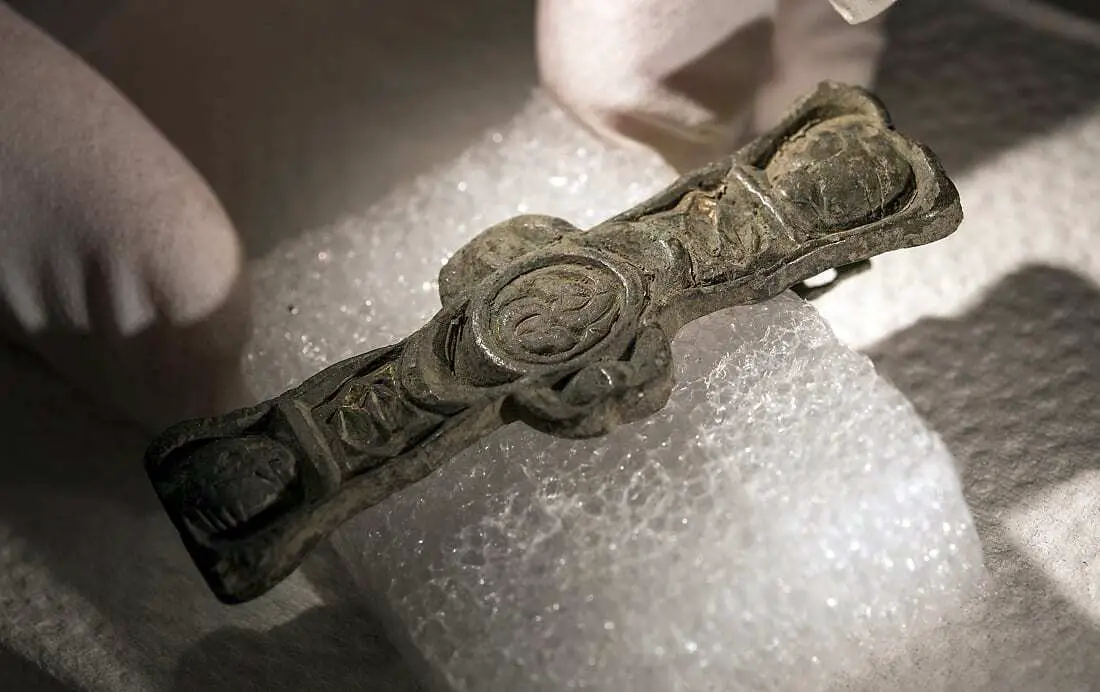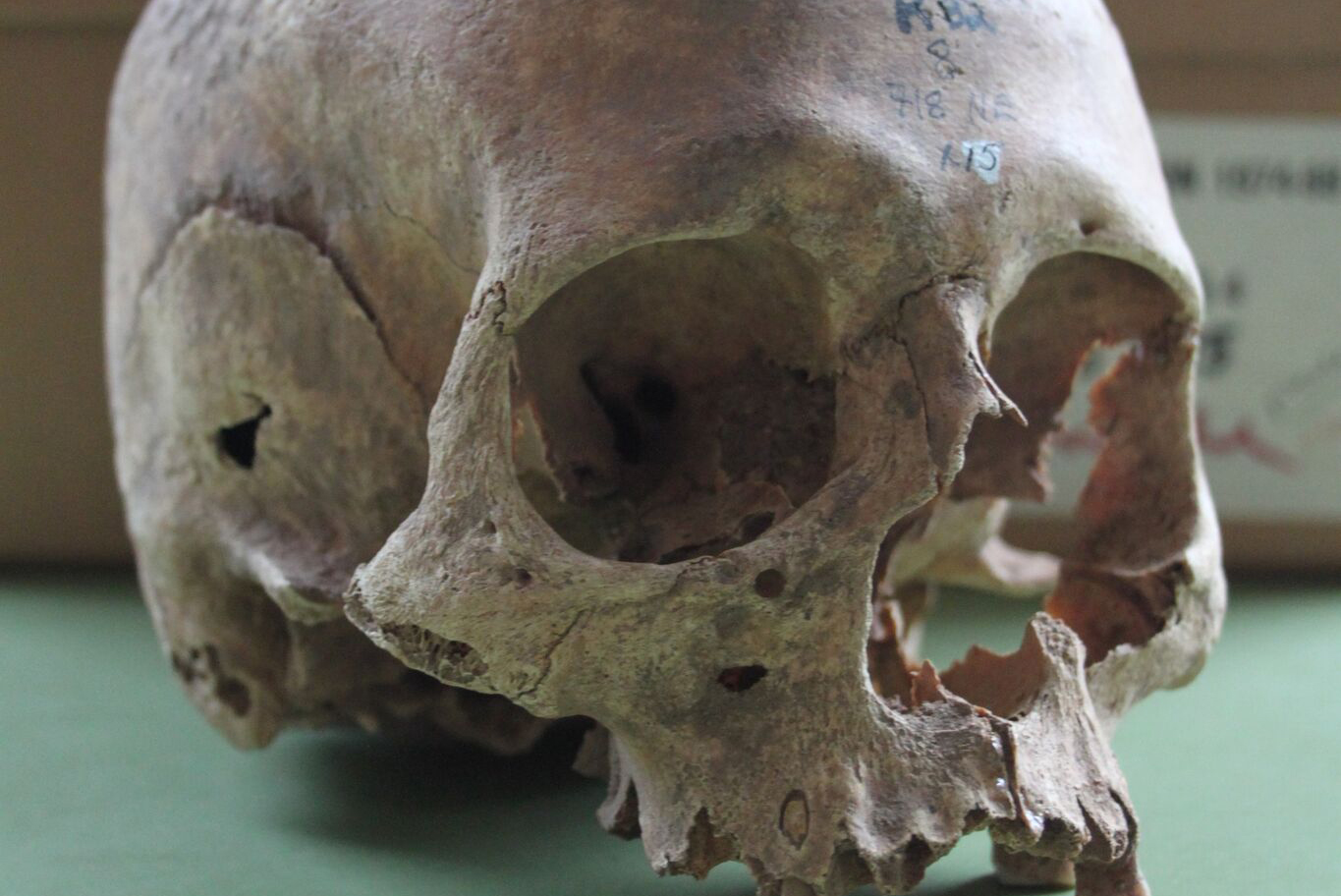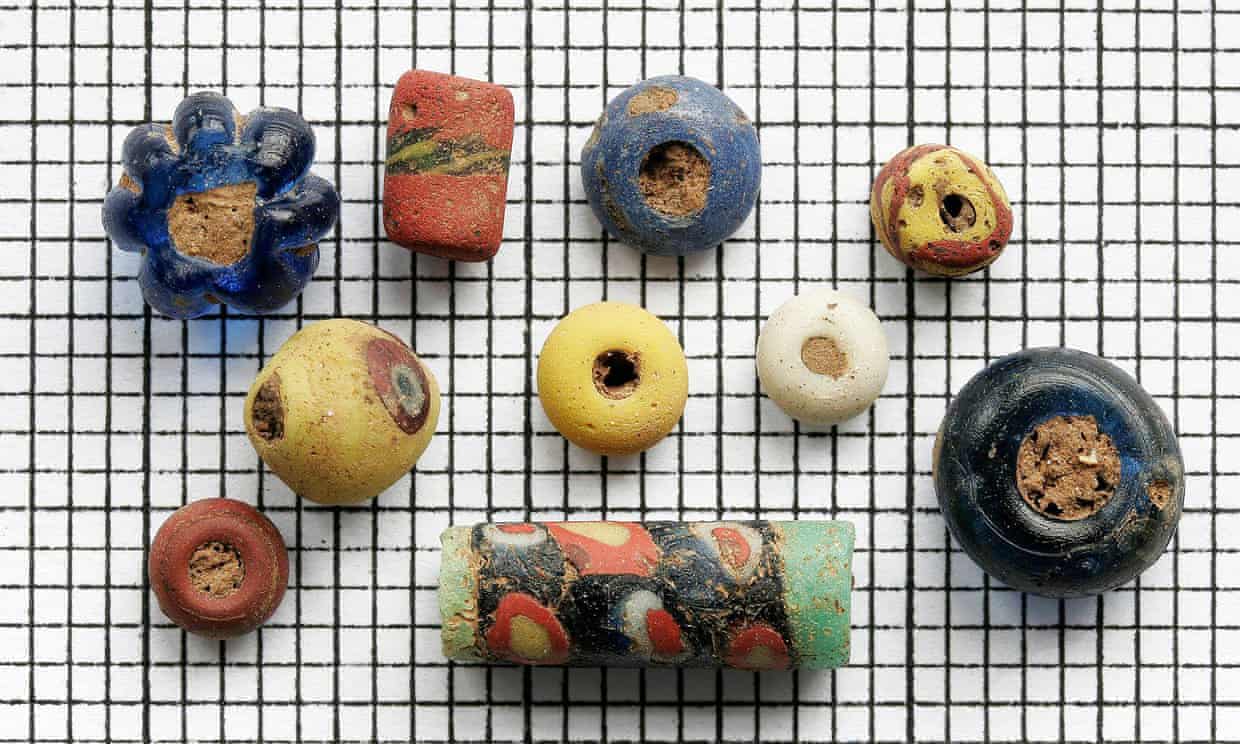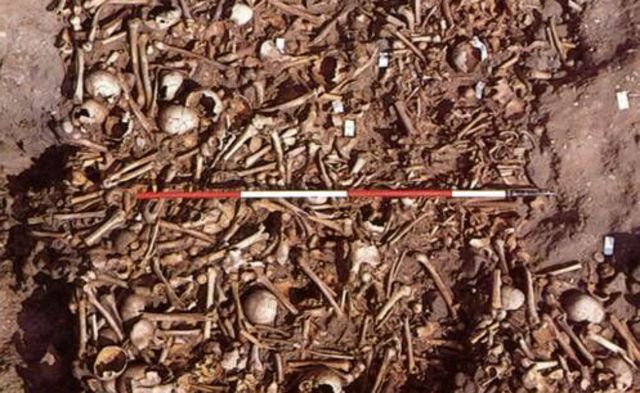Lavishly illustrated 1,200-year-old copy of Gospels previously thought to have been thought to have been created as one book
The Book of Kells is the centrepiece of an exhibition which attracts over 500,000 visitors to Trinity College in Dublin each year Jeff Pioquinto/Flickr
New research is rewriting the history of the world’s most famous early medieval manuscript – a lavishly illustrated 1,200-year-old copy of the Gospels known today as the Book of Kells.
It had always been assumed that the work – which includes 150 square feet of spectacular coloured illustrations – was conceived and created as one book, containing all four Gospels.
But a detailed analysis of the texts has led a leading expert on early medieval illuminated manuscripts, Dr Bernard Meehan of Trinity College, Dublin, to conclude that the book was originally two separate works that were, in the main, created up to half a century apart
Dr Meehan's new hypothesis suggests that the last part of the Book of Kells (namely St John’s Gospel) and the first few pages of St Mark’s Gospel were created by a potentially quite elderly scribe on the Scottish island of Iona sometime during the last quarter of the eighth century.
Read the rest of this article...
Archaeological news about the Archaeology of Early Medieval Europe from the Archaeology in Europe web site
Thursday, 8 February 2018
Mass grave of Viking army contained slaughtered children to help dead reach afterlife, experts believe
The grave of the four youngsters who may have been killed in a burial ritual
CREDIT: UNIVERSITY OF BRISTOL
A mass grave of Viking warriors found in Derbyshire was accompanied by slaughtered children in a burial ritual enacted to help the dead reach the afterlife, archaeologists believe.
Experts from the University of Bristol have reexamined a huge pit of bones uncovered in the 1970s and 80s in Repton.
Examinations at the the time suggested the grave spanned centuries, but new radiocarbon analysis has revealed the skeletons actually belong to soldiers from the Great Viking Army, which drove Burgred, the king of Mercia into exile in 873AD.
The excavators also found four youngsters aged between eight and 18 buried together in a single grave with a sheep jaw at their feet, which they dated to the same period. At least two showed signs of traumatic injury suggesting they may have been sacrificed in a ritual to accompany the dead.
Bristol archaeologist Cat Jarman said: “The grave is very unusual. I don't know of any examples of four young people buried in a single grave like this from anywhere else in England in this period.
Read the rest of this article...
Tuesday, 6 February 2018
Viking imported finds discovered in cemetery works
EXPANSION WORKS OF BYNESET CEMETERY AT STEINE CHURCH IN TRONDHEIM, NORWAY HAS LED TO THE DISCOVERY OF AN IMPORTED CLASP OR BROOCH DATING FROM THE VIKING ERA.
The find is thought to be a gold-plated silver fitting from a book brought to the area during the Viking age.
Raymond Sauvage from NTNU’s Department of Archaeology and Cultural History, and the project manager for the excavations said “We know that the Vikings went out on raids. They went to Ireland and brought things back”
“You don’t make discoveries like this everywhere. There are only a few areas where people had the resources to go out on such voyages.”
Read the rest of this article...
FORTRESS TOWER OF ANCIENT ODESSOS FOUND BY CHANCE
Part of a U-shape fortress tower from the Late Antiquity fortress wall of ancient Odessos (Odessus) has been discovered in the cellar of a house in Bulgaria’s Black Sea city of Varna.
Photo: Varna Museum of Archaeology
A Late Antiquity fortress wall tower from the Ancient Thracian, Greek, and Roman city of Odessos (Odessus) has been discovered by accident in the Black Sea city of Varna, with rescue archaeological excavations affirming data about the existence of Quaestura Exercitus, a peculiar administrative district in 6th century AD Byzantium (i.e. the Eastern Roman Empire), under Emperor Justinian I the Great, uniting much of today’s Northern Bulgaria with Cyprus, parts of Anatolia, and the Cyclades.
Parts of a U-shaped fortress tower have been discovered by accident in the cellar of a house at 13 Voden Street in Bulgaria’s Black Sea city of Varna, within the Odessos Archaeological Preserve.
Ensuing rescue excavations have explored the ruins of the tower, which has been found to be part of one of the known fortress walls of ancient Odessos, the Varna Museum of Archaeology has announced, as cited by local news site Varna24.
Read the rest of this article...
Monday, 5 February 2018
Radiocarbon dating reveals mass grave did date to the Viking age
A team of archaeologists, led by Cat Jarman from the University of Bristol's Department of Anthropology and Archaeology, has discovered that a mass grave uncovered in the 1980s dates to the Viking Age and may have been a burial site of the Viking Great Army war dead.
Although the remains were initially thought to be associated with the Vikings, radiocarbon dates seemed to suggest the grave consisted of bones collected over several centuries. New scientific research, published in Antiquity, now shows that this was not the case and that the bones are all consistent with a date in the late 9th century. Historical records state that the Viking Great Army wintered in Repton, Derbyshire, in 873 A.D. and drove the Mercian king into exile.
Excavations led by archaeologists Martin Biddle and Birthe Kjølbye-Biddle at St Wystan's Church in Repton in the 1970s and 1980s discovered several Viking graves and a charnel deposit of nearly 300 people underneath a shallow mound in the vicarage garden.
The mound appears to have been a burial monument linked to the Great Army.
An Anglo-Saxon building, possibly a royal mausoleum, was cut down and partially ruined, before being turned into a burial chamber.
Read the rest of this article...
One of the female skulls from the Repton charnel [Credit: Cat Jarman]
Although the remains were initially thought to be associated with the Vikings, radiocarbon dates seemed to suggest the grave consisted of bones collected over several centuries. New scientific research, published in Antiquity, now shows that this was not the case and that the bones are all consistent with a date in the late 9th century. Historical records state that the Viking Great Army wintered in Repton, Derbyshire, in 873 A.D. and drove the Mercian king into exile.
Excavations led by archaeologists Martin Biddle and Birthe Kjølbye-Biddle at St Wystan's Church in Repton in the 1970s and 1980s discovered several Viking graves and a charnel deposit of nearly 300 people underneath a shallow mound in the vicarage garden.
The mound appears to have been a burial monument linked to the Great Army.
An Anglo-Saxon building, possibly a royal mausoleum, was cut down and partially ruined, before being turned into a burial chamber.
Read the rest of this article...
This Mass Grave May Belong to 'Great Viking Army'
Bones are yielding new clues about the massive, mysterious Viking forces that invaded England.
A photo taken at a 1982 excavation of the gravesite shows remains from what may belong to the Great Viking Army.
PHOTOGRAPH BY MARTIN BIDDLE
For years, archaeologists were stumped. What happened to the Great Viking Army, a massive force that seized great swaths of England in the 9th century but left barely a trace?
Archaeologists now report that a mass grave in England may contain nearly 300 Viking warriors—the only remains of the Great Viking Army’s warriors ever found.Archaeologists first uncovered the burial site in the 1980s, in Derbyshire, England, and thought it might contain remains from the Great Viking Army, also known the Great Heathen Army. But there was one problem—radiocarbon dating of the site revealed that the remains were too old to be Viking invaders.
Read the rest of this article...
Archaeologists now report that a mass grave in England may contain nearly 300 Viking warriors—the only remains of the Great Viking Army’s warriors ever found.Archaeologists first uncovered the burial site in the 1980s, in Derbyshire, England, and thought it might contain remains from the Great Viking Army, also known the Great Heathen Army. But there was one problem—radiocarbon dating of the site revealed that the remains were too old to be Viking invaders.
Read the rest of this article...
Sunday, 4 February 2018
Midlands mass grave was burial site for Viking 'Great Heathen Army' war dead, new study reveals
The powerful Norse army was sent to invade the four Anglo-Saxon kingdoms that constituted England in 865 AD.
In the 70s, a mysterious mass grave complex, containing the remains of hundreds of people, was unearthed by archaeologists in Repton, Derbyshire. The initial signs indicated that the burial site was associated with a Viking army, however, radiocarbon dating seemed to pour cold water on this hypothesis, suggesting that the bones had actually been left there over several centuries.
Now, new research has revealed that, in fact, the remains are consistent with a date in the 9th century. Based on these findings, Cat Jarman and colleagues from the University of Bristol's Department of Anthropology and Archaeology suggest that the mass grave was a burial site for the war dead of the Viking Great Army.
This military force – known by the Anglo-Saxons as the Great Heathen Army – was a powerful coalition of Norse warriors mainly originating from Denmark, although some came from Sweden and Norway, who banded together under a unified command to invade the four Anglo-Saxon kingdoms that constituted England in 865 AD.
Historical records indicate that this army spent the winter at Repton in 873 AD, driving the king of Mercia – one of the Anglo-Saxon kingdoms, centred on the midlands – into exile in the process.
Read the rest of this article...
One of the female skulls excavated from the Repton burial site Cat Jarman
In the 70s, a mysterious mass grave complex, containing the remains of hundreds of people, was unearthed by archaeologists in Repton, Derbyshire. The initial signs indicated that the burial site was associated with a Viking army, however, radiocarbon dating seemed to pour cold water on this hypothesis, suggesting that the bones had actually been left there over several centuries.
Now, new research has revealed that, in fact, the remains are consistent with a date in the 9th century. Based on these findings, Cat Jarman and colleagues from the University of Bristol's Department of Anthropology and Archaeology suggest that the mass grave was a burial site for the war dead of the Viking Great Army.
This military force – known by the Anglo-Saxons as the Great Heathen Army – was a powerful coalition of Norse warriors mainly originating from Denmark, although some came from Sweden and Norway, who banded together under a unified command to invade the four Anglo-Saxon kingdoms that constituted England in 865 AD.
Historical records indicate that this army spent the winter at Repton in 873 AD, driving the king of Mercia – one of the Anglo-Saxon kingdoms, centred on the midlands – into exile in the process.
Read the rest of this article...
Melting Glaciers Could Reveal How Our Ancestors Dealt With Changing Climates
While some archaeologists dig with trowels and shovels, others use a warming planet to their advantage.
Archaeologist holding a c. 1400-year-old arrow, lost reindeer hunting in the high mountains of Oppland, Norway, during the Late Antique Little Ice Age.
PHOTOGRAPH BYJULIAN MARTINSEN, SECRETS OF THE ICE OPPLAND COUNTY COUNCIL
When Lars Pilø, co-director of the Glacier Archaeology Program at Oppland County Council, noticed Norway was experiencing a particularly warm autumn in 2006, the archaeologist turned to the mountains. If climate change was thawing glacial ice, what did that mean for the artifacts that were emerging from the melt? So, starting officially in 2011, Pilø and an international team took to Norway's icy Jotunheimen and Oppland mountains to see what ancient objects they could rescue from the snowmelt.
Over the years, the archaeologists uncovered thousands of artifacts, some of which date back 6,000 years. Since the ice acts like a giant freezer and preserves the objects, the finds look like they could have been uncovered yesterday. (Read: "Alaska's Thaw Reveals—And Threatens—A Culture's Artifacts")
"The moment these artifacts melt out of the ice, they're immediately vulnerable to the elements," says James H. Barrett, a University of Cambridge environmental archaeologist.
The glacier archaeologists detailed their findings in a Royal Society Open Science paper published January 24. Pilø and Barrett are authors on the paper.
Read the rest of this article...
Melting Glaciers Could Reveal How Our Ancestors Dealt With Changing Climates
While some archaeologists dig with trowels and shovels, others use a warming planet to their advantage.
Archaeologist holding a c. 1400-year-old arrow, lost reindeer hunting in the high mountains of Oppland, Norway, during the Late Antique Little Ice Age.
PHOTOGRAPH BYJULIAN MARTINSEN, SECRETS OF THE ICE OPPLAND COUNTY COUNCIL
When Lars Pilø, co-director of the Glacier Archaeology Program at Oppland County Council, noticed Norway was experiencing a particularly warm autumn in 2006, the archaeologist turned to the mountains. If climate change was thawing glacial ice, what did that mean for the artifacts that were emerging from the melt? So, starting officially in 2011, Pilø and an international team took to Norway's icy Jotunheimen and Oppland mountains to see what ancient objects they could rescue from the snowmelt.
Over the years, the archaeologists uncovered thousands of artifacts, some of which date back 6,000 years. Since the ice acts like a giant freezer and preserves the objects, the finds look like they could have been uncovered yesterday. (Read: "Alaska's Thaw Reveals—And Threatens—A Culture's Artifacts")
"The moment these artifacts melt out of the ice, they're immediately vulnerable to the elements," says James H. Barrett, a University of Cambridge environmental archaeologist.
The glacier archaeologists detailed their findings in a Royal Society Open Science paper published January 24. Pilø and Barrett are authors on the paper.
Read the rest of this article...
Friday, 2 February 2018
Canterbury artefacts 'may have been stolen by metal thieves'
Two suspected metal thieves are believed to be behind the theft of an archaeological hoard including hundreds of Anglo-Saxon beads and iron age coins, having apparently stumbled on the artefacts while scavenging for copper pipes and wiring.
Canterbury Archaeological Trust is appealing for the public’s help in scanning online sale sites such as eBay for any sign of the artefacts stolen in three raids last month at its warehouse, in the north-east of the city.
The trust is also furious with its landlord, Canterbury city council, because it claims the council failed to inform it, or the police, about metal theft on an adjacent derelict site.
The trust’s archive manager, Andrew Richardson, is devastated by the loss of at least 1,500 items, including Anglo-Saxon brooches and coins each worth thousands of pounds.
Read the rest of this article...
Thieves steal hundreds of priceless artefacts from Canterbury charity
Priceless artefacts including 850 Anglo-Saxon beads have been stolen from an archaeological charity in Canterbury during a series of break-ins.
Thieves broke into the store of the Canterbury Archaeological Trust, which undertakes excavations and research and educates the public about archaeology, twice last week and once over the weekend.
As well as the beads, large quantities of coins and metal artefacts, and an assortment of bone objects have been stolen.
The charity has put on an appeal asking the public to look out for the historical items being offered for sale.
The trust’s outreach and archive manager Dr Andrew Richardson told the Guardian: “It’s been pretty distressing for everyone at the trust, not only because of the lost items but also the scale of the damage.
Read the rest of this article...
Bones clue to 'lost' Viking army which made England
The mass grave was first excavated in the 1970s and 80s
Martin Biddle
A lost Viking army which was a "key part" of the creation of England may have been identified by archaeologists.
More than 250 skeletons found at St Wystan's church, Repton, Derbyshire, have been dated to the 9th Century.
Chronicles state a "large heathen army" began to hack its way across England in 866AD, toppling Anglo-Saxon kings until being halted by Alfred the Great.
Cat Jarman from the University of Bristol said: "This army had left almost no trace, but maybe here it is."
Read the rest of this article...
Subscribe to:
Comments (Atom)









